Yunhao Yang
Foundation Models for Logistics: Toward Certifiable, Conversational Planning Interfaces
Jul 15, 2025Abstract:Logistics operators, from battlefield coordinators rerouting airlifts ahead of a storm to warehouse managers juggling late trucks, often face life-critical decisions that demand both domain expertise and rapid and continuous replanning. While popular methods like integer programming yield logistics plans that satisfy user-defined logical constraints, they are slow and assume an idealized mathematical model of the environment that does not account for uncertainty. On the other hand, large language models (LLMs) can handle uncertainty and promise to accelerate replanning while lowering the barrier to entry by translating free-form utterances into executable plans, yet they remain prone to misinterpretations and hallucinations that jeopardize safety and cost. We introduce a neurosymbolic framework that pairs the accessibility of natural-language dialogue with verifiable guarantees on goal interpretation. It converts user requests into structured planning specifications, quantifies its own uncertainty at the field and token level, and invokes an interactive clarification loop whenever confidence falls below an adaptive threshold. A lightweight model, fine-tuned on just 100 uncertainty-filtered examples, surpasses the zero-shot performance of GPT-4.1 while cutting inference latency by nearly 50%. These preliminary results highlight a practical path toward certifiable, real-time, and user-aligned decision-making for complex logistics.
Real-Time Privacy Preservation for Robot Visual Perception
May 08, 2025Abstract:Many robots (e.g., iRobot's Roomba) operate based on visual observations from live video streams, and such observations may inadvertently include privacy-sensitive objects, such as personal identifiers. Existing approaches for preserving privacy rely on deep learning models, differential privacy, or cryptography. They lack guarantees for the complete concealment of all sensitive objects. Guaranteeing concealment requires post-processing techniques and thus is inadequate for real-time video streams. We develop a method for privacy-constrained video streaming, PCVS, that conceals sensitive objects within real-time video streams. PCVS takes a logical specification constraining the existence of privacy-sensitive objects, e.g., never show faces when a person exists. It uses a detection model to evaluate the existence of these objects in each incoming frame. Then, it blurs out a subset of objects such that the existence of the remaining objects satisfies the specification. We then propose a conformal prediction approach to (i) establish a theoretical lower bound on the probability of the existence of these objects in a sequence of frames satisfying the specification and (ii) update the bound with the arrival of each subsequent frame. Quantitative evaluations show that PCVS achieves over 95 percent specification satisfaction rate in multiple datasets, significantly outperforming other methods. The satisfaction rate is consistently above the theoretical bounds across all datasets, indicating that the established bounds hold. Additionally, we deploy PCVS on robots in real-time operation and show that the robots operate normally without being compromised when PCVS conceals objects.
Evaluating Human Trust in LLM-Based Planners: A Preliminary Study
Feb 27, 2025Abstract:Large Language Models (LLMs) are increasingly used for planning tasks, offering unique capabilities not found in classical planners such as generating explanations and iterative refinement. However, trust--a critical factor in the adoption of planning systems--remains underexplored in the context of LLM-based planning tasks. This study bridges this gap by comparing human trust in LLM-based planners with classical planners through a user study in a Planning Domain Definition Language (PDDL) domain. Combining subjective measures, such as trust questionnaires, with objective metrics like evaluation accuracy, our findings reveal that correctness is the primary driver of trust and performance. Explanations provided by the LLM improved evaluation accuracy but had limited impact on trust, while plan refinement showed potential for increasing trust without significantly enhancing evaluation accuracy.
Any2Any: Incomplete Multimodal Retrieval with Conformal Prediction
Nov 25, 2024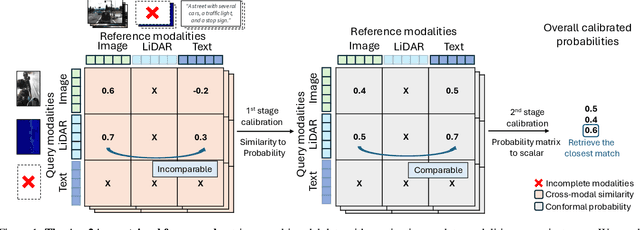

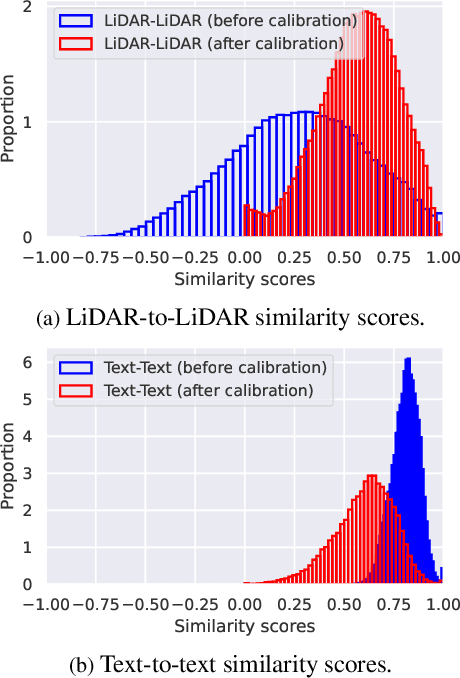
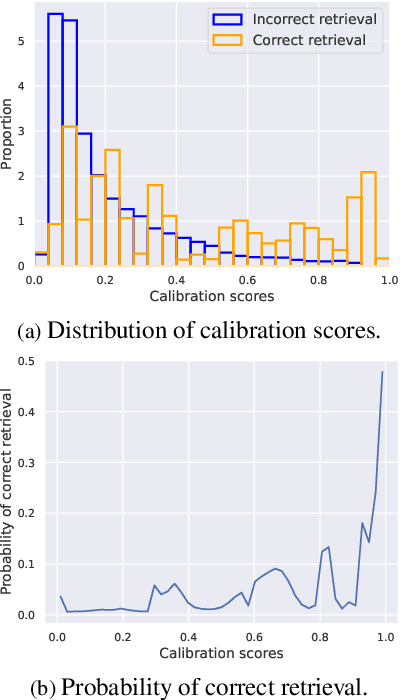
Abstract:Autonomous agents perceive and interpret their surroundings by integrating multimodal inputs, such as vision, audio, and LiDAR. These perceptual modalities support retrieval tasks, such as place recognition in robotics. However, current multimodal retrieval systems encounter difficulties when parts of the data are missing due to sensor failures or inaccessibility, such as silent videos or LiDAR scans lacking RGB information. We propose Any2Any-a novel retrieval framework that addresses scenarios where both query and reference instances have incomplete modalities. Unlike previous methods limited to the imputation of two modalities, Any2Any handles any number of modalities without training generative models. It calculates pairwise similarities with cross-modal encoders and employs a two-stage calibration process with conformal prediction to align the similarities. Any2Any enables effective retrieval across multimodal datasets, e.g., text-LiDAR and text-time series. It achieves a Recall@5 of 35% on the KITTI dataset, which is on par with baseline models with complete modalities.
Know Where You're Uncertain When Planning with Multimodal Foundation Models: A Formal Framework
Nov 03, 2024Abstract:Multimodal foundation models offer a promising framework for robotic perception and planning by processing sensory inputs to generate actionable plans. However, addressing uncertainty in both perception (sensory interpretation) and decision-making (plan generation) remains a critical challenge for ensuring task reliability. We present a comprehensive framework to disentangle, quantify, and mitigate these two forms of uncertainty. We first introduce a framework for uncertainty disentanglement, isolating perception uncertainty arising from limitations in visual understanding and decision uncertainty relating to the robustness of generated plans. To quantify each type of uncertainty, we propose methods tailored to the unique properties of perception and decision-making: we use conformal prediction to calibrate perception uncertainty and introduce Formal-Methods-Driven Prediction (FMDP) to quantify decision uncertainty, leveraging formal verification techniques for theoretical guarantees. Building on this quantification, we implement two targeted intervention mechanisms: an active sensing process that dynamically re-observes high-uncertainty scenes to enhance visual input quality and an automated refinement procedure that fine-tunes the model on high-certainty data, improving its capability to meet task specifications. Empirical validation in real-world and simulated robotic tasks demonstrates that our uncertainty disentanglement framework reduces variability by up to 40% and enhances task success rates by 5% compared to baselines. These improvements are attributed to the combined effect of both interventions and highlight the importance of uncertainty disentanglement which facilitates targeted interventions that enhance the robustness and reliability of autonomous systems.
Joint Verification and Refinement of Language Models for Safety-Constrained Planning
Oct 18, 2024Abstract:Although pre-trained language models can generate executable plans (e.g., programmatic policies) for solving robot tasks, the generated plans may violate task-relevant logical specifications due to the models' black-box nature. A significant gap remains between the language models' outputs and verifiable executions of plans. We develop a method to generate executable plans and formally verify them against task-relevant safety specifications. Given a high-level task description in natural language, the proposed method queries a language model to generate plans in the form of executable robot programs. It then converts the generated plan into an automaton-based representation, allowing formal verification of the automaton against the specifications. We prove that given a set of verified plans, the composition of these plans also satisfies the safety specifications. This proof ensures the safety of complex, multi-component plans, obviating the computation complexity of verifying the composed plan. We then propose an automated fine-tuning process that refines the language model to generate specification-compliant plans without the need for human labeling. The empirical results show a 30 percent improvement in the probability of generating plans that meet task specifications after fine-tuning.
Reasoning, Memorization, and Fine-Tuning Language Models for Non-Cooperative Games
Oct 18, 2024



Abstract:We develop a method that integrates the tree of thoughts and multi-agent framework to enhance the capability of pre-trained language models in solving complex, unfamiliar games. The method decomposes game-solving into four incremental tasks -- game summarization, area selection, action extraction, and action validation -- each assigned to a specific language-model agent. By constructing a tree of thoughts, the method simulates reasoning paths and allows agents to collaboratively distill game representations and tactics, mitigating the limitations of language models in reasoning and long-term memorization. Additionally, an automated fine-tuning process further optimizes the agents' performance by ranking query-response pairs based on game outcomes, e.g., winning or losing. We apply the method to a non-cooperative game and demonstrate a 65 percent winning rate against benchmark algorithms, with an additional 10 percent improvement after fine-tuning. In contrast to existing deep learning algorithms for game solving that require millions of training samples, the proposed method consumes approximately 1000 training samples, highlighting its efficiency and scalability.
Uncertainty-Guided Enhancement on Driving Perception System via Foundation Models
Oct 02, 2024



Abstract:Multimodal foundation models offer promising advancements for enhancing driving perception systems, but their high computational and financial costs pose challenges. We develop a method that leverages foundation models to refine predictions from existing driving perception models -- such as enhancing object classification accuracy -- while minimizing the frequency of using these resource-intensive models. The method quantitatively characterizes uncertainties in the perception model's predictions and engages the foundation model only when these uncertainties exceed a pre-specified threshold. Specifically, it characterizes uncertainty by calibrating the perception model's confidence scores into theoretical lower bounds on the probability of correct predictions using conformal prediction. Then, it sends images to the foundation model and queries for refining the predictions only if the theoretical bound of the perception model's outcome is below the threshold. Additionally, we propose a temporal inference mechanism that enhances prediction accuracy by integrating historical predictions, leading to tighter theoretical bounds. The method demonstrates a 10 to 15 percent improvement in prediction accuracy and reduces the number of queries to the foundation model by 50 percent, based on quantitative evaluations from driving datasets.
Neuro-Symbolic Video Search
Mar 16, 2024Abstract:The unprecedented surge in video data production in recent years necessitates efficient tools to extract meaningful frames from videos for downstream tasks. Long-term temporal reasoning is a key desideratum for frame retrieval systems. While state-of-the-art foundation models, like VideoLLaMA and ViCLIP, are proficient in short-term semantic understanding, they surprisingly fail at long-term reasoning across frames. A key reason for this failure is that they intertwine per-frame perception and temporal reasoning into a single deep network. Hence, decoupling but co-designing semantic understanding and temporal reasoning is essential for efficient scene identification. We propose a system that leverages vision-language models for semantic understanding of individual frames but effectively reasons about the long-term evolution of events using state machines and temporal logic (TL) formulae that inherently capture memory. Our TL-based reasoning improves the F1 score of complex event identification by 9-15% compared to benchmarks that use GPT4 for reasoning on state-of-the-art self-driving datasets such as Waymo and NuScenes.
Fine-Tuning Language Models Using Formal Methods Feedback
Oct 27, 2023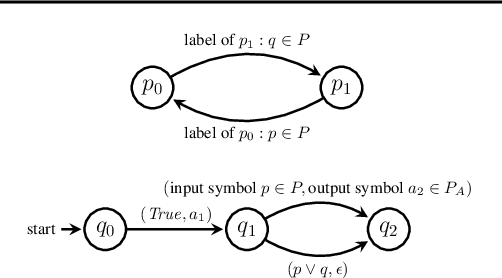
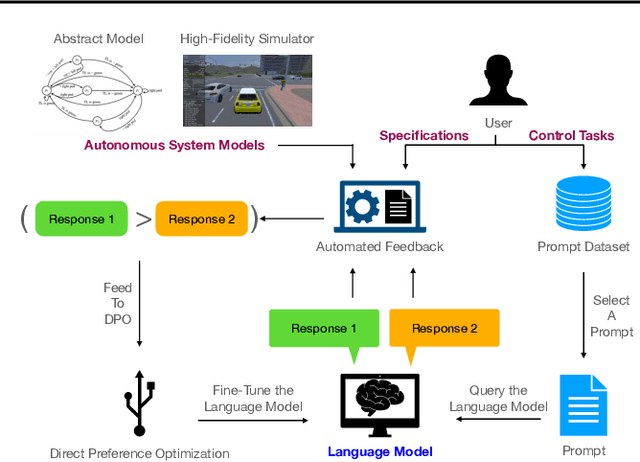

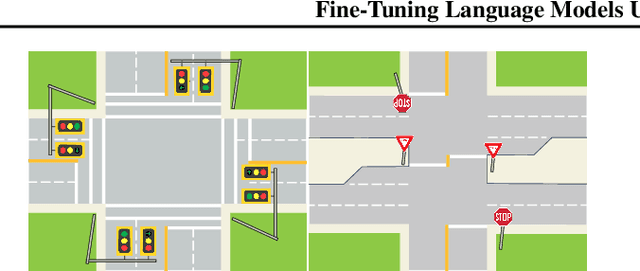
Abstract:Although pre-trained language models encode generic knowledge beneficial for planning and control, they may fail to generate appropriate control policies for domain-specific tasks. Existing fine-tuning methods use human feedback to address this limitation, however, sourcing human feedback is labor intensive and costly. We present a fully automated approach to fine-tune pre-trained language models for applications in autonomous systems, bridging the gap between generic knowledge and domain-specific requirements while reducing cost. The method synthesizes automaton-based controllers from pre-trained models guided by natural language task descriptions. These controllers are verifiable against independently provided specifications within a world model, which can be abstract or obtained from a high-fidelity simulator. Controllers with high compliance with the desired specifications receive higher ranks, guiding the iterative fine-tuning process. We provide quantitative evidences, primarily in autonomous driving, to demonstrate the method's effectiveness across multiple tasks. The results indicate an improvement in percentage of specifications satisfied by the controller from 60% to 90%.
 Add to Chrome
Add to Chrome Add to Firefox
Add to Firefox Add to Edge
Add to Edge